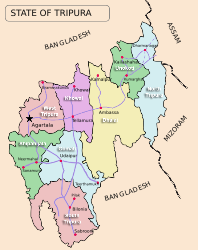South Tripura
| South Tripura District | |
|---|---|

|
|
| State | Tripura |
| Administrative headquarters : | Belonia |
| Area : | 1514.32 km² |
| Residents : | 446,764 (2011) |
| Population density : | 295 inhabitants / km² |
| Website : | official website |
The South Tripura District is a district in the Indian state of Tripura . The administrative seat is the city of Belonia .
geography
The South Tripura district is located in the far south of Tripura on the border with Bangladesh . The area of the district is 1514 square kilometers. Neighboring districts are the Gomati districts in the north, northeast and east and Sipahijala in the northwest. In the southeast, south and west, the district borders on India's neighboring state, Bangladesh.
history
The district was created when the administrative areas of Tripura were created on September 1, 1970. In 1995, areas of the previous district of South Tripura changed to the new district of Dhalai . In 2012, its area decreased again with the establishment of the Gomati district .
population
According to the 2011 census, the district of South Tripura has 446,764 inhabitants. With 295 inhabitants per square kilometer, the district is very densely populated. Of the 446,764 residents, 407,705 people (91.26 percent) lived in rural communities and 39,059 people in urban areas.
The district of South Tripura is one of the areas of India in which numerous members of the "tribal population" ( scheduled tribes ) settle. Among them were (2011) 167,479 people (37.49 percent of the district population). In 2011, 65,771 people (14.72 percent of the district's population) belonged to the Dalit ( scheduled castes ).
Population development
South Tripura district in the boundaries until 2012
Tripura was divided into three districts in 1970 - North Tripura, South Tripura and West Tripura. The population development from 1971 to 2011 in the limits before 2012 was as follows:

Today's limits
As everywhere in India, the population in the South Tripura district has been growing rapidly for decades. The 2001 Indian census found a population of 391,841 people. The increase in the years 2001–2011 was more than 14 percent (14.02%). In these ten years the population increased by around 55,000 people.
Significant places
There are three urban settlements in the district with the district capital Belonia, Sabroom and Santirbazar.

District population by gender
Of the 446,764 residents, 228,361 (51.11 percent) were male and 218,403 female. This is typical of India, where there is usually a significant increase in men.
District population by language
A clear majority of over 60 percent of the population speaks Bengali as their mother tongue. In the cities it is even over 90 percent. In the RD blocks, the Bengali-speaking residents are always the strongest language group with between 49.8 percent (in Bokafa) and 79 percent in Rajnagar. An exception is the RD Block Rupaichhari with a very mixed population. There, the Bengali speakers are only third behind Kokborok and Mogh with 6828 of the 47,976 inhabitants. The majority of the few Hindi-speaking residents live in the RD blocks of Hrishyamukh, Rajnagar and Rupaichhari. The following table shows the language conditions in 2011:
| year | Bengali | Kokborok | Mogh | Tripuri | Chakma | Hindi | Other languages | Total | ||||||||
|---|---|---|---|---|---|---|---|---|---|---|---|---|---|---|---|---|
| number | % | number | % | number | % | number | % | number | % | number | % | number | % | number | % | |
| 2011 | 271,481 | 60.77 | 100,138 | 22.41 | 27,855 | 6.23 | 21,473 | 4.81 | 7874 | 1.76 | 6650 | 1.49 | 11,293 | 2.53 | 446.764 | 100.00% |
| Source: 2011 census result | ||||||||||||||||
Population of the district by confession
The majority of the residents profess Hinduism. The majority of Bengali and Hindi speakers belong to their appendix. A small minority among the Bengalis profess Islam. The Buddhists limit themselves almost entirely to the language groups of the Chakma and Mogh. And that's why they are well represented in the RD blocks Bokafa and Rupaichhari. The majority of Christians belong to the “scheduled tribes” (tribal population) and the Dalit (also “untouchables”, casteless). In the RD Block Boxanagar, the Muslims are even in the majority. In the RD Blocks Bishalgarh, Kathalia and Melagarh they are significant minorities with shares between 15 and 40 percent. The following table shows the exact religious composition of the population:
| year | Buddhists | Christians | Hindus | Jainas | Muslims | Sikhs | Other | not specified | Total | |||||||||
|---|---|---|---|---|---|---|---|---|---|---|---|---|---|---|---|---|---|---|
| number | % | number | % | number | % | number | % | number | % | number | % | number | % | number | % | number | % | |
| 2011 | 37.126 | 8.31 | 10,975 | 2.46 | 386,823 | 86.58 | 64 | 0.01 | 11,119 | 2.49 | 133 | 0.03 | 238 | 0.05 | 286 | 0.06 | 446.764 | 100.00% |
| Source: 2011 census result | ||||||||||||||||||
education
The goal of full literacy is within reach. Of the 388,799 people aged seven and over, 325,529 (83.73 percent) can read and write. Literacy is well above the Indian average.
administration
With Belonia, Sabroom and Santirbazar, the new district has three sub-divisions (subdistricts), which are divided into the eight RD blocks Bharat Chandra Nagar, Bokafa, Hrishyamukh, Jolaibari, Poangbari, Rajnagar, Rupaichari and Satchand.
Individual evidence
Web links
Coordinates: 23 ° 19 ′ 12 ″ N , 91 ° 17 ′ 24 ″ E